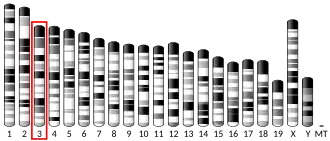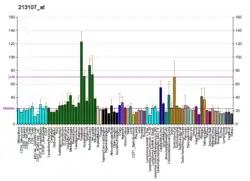TNIK
TRAF2 and NCK-interacting protein kinase is an enzyme that in humans is encoded by the TNIK gene.[5][6][7] TNIK is involved in various cellular processes, including signal transduction, gene transcription, and cytoskeletal organization. As an emerging area of therapeutic research, TNIK inhibitors have shown potential in addressing a range of diseases, including cancer, neurological disorders, and inflammatory conditions.[8][9][10]
Structure
Germinal center kinases (GCKs), such as TNIK, are characterized by an N-terminal kinase domain and a C-terminal GCK domain that serves a regulatory function.[6][7]
Function
TNIK is a serine/threonine kinase that plays a central role in diverse cellular processes, most notably as a key regulator of the Wnt signaling pathway.[11] TNIK is recruited to the promoters of Wnt target genes where it interacts with both β-catenin and TCF4; it phosphorylates TCF4 to enable TCF/LEF-dependent transcriptional activation of Wnt target genes, a function critical for cell proliferation and stem cell maintenance, especially in intestinal and cancerous tissues.[11]
Interactions
TNIK has been shown to interact with KIAA0090,[12] although the significance is unclear. TNIK has been shown to phosphorylate Gelsolin, a protein involved in F-actin depolymerisation thus inducing cytoskeletal changes.[6]
Clinical significance
TNIK plays an important role in pulmonary fibrosis. TNIK inhibitors are used in the treatment of pulmonary fibrosis.[9] TNIK has increasingly been of interest in research into the biology of ageing.[13]
References
- ^ a b c GRCh38: Ensembl release 89: ENSG00000154310 – Ensembl, May 2017
- ^ a b c GRCm38: Ensembl release 89: ENSMUSG00000027692 – Ensembl, May 2017
- ^ "Human PubMed Reference:". National Center for Biotechnology Information, U.S. National Library of Medicine.
- ^ "Mouse PubMed Reference:". National Center for Biotechnology Information, U.S. National Library of Medicine.
- ^ Nagase T, Ishikawa K, Miyajima N, Tanaka A, Kotani H, Nomura N, et al. (Aug 1998). "Prediction of the coding sequences of unidentified human genes. IX. The complete sequences of 100 new cDNA clones from brain which can code for large proteins in vitro". DNA Research : an International Journal for Rapid Publication of Reports on Genes and Genomes. 5 (1): 31–39. doi:10.1093/dnares/5.1.31. PMID 9628581.
- ^ a b c Fu CA, Shen M, Huang BC, Lasaga J, Payan DG, Luo Y (Nov 1999). "TNIK, a novel member of the germinal center kinase family that activates the c-Jun N-terminal kinase pathway and regulates the cytoskeleton". Journal of Biological Chemistry. 274 (43): 30729–30737. doi:10.1074/jbc.274.43.30729. PMID 10521462.
- ^ a b "Entrez Gene: TNIK TRAF2 and NCK interacting kinase".
- ^ Yamada T, Masuda M (May 2017). "Emergence of TNIK inhibitors in cancer therapeutics". Cancer Science. 108 (5): 818–823. doi:10.1111/cas.13203. PMC 5448614. PMID 28208209.
- ^ a b Garneau-Tsodikova S, Thannickal VJ (2008). "Protein kinase inhibitors in the treatment of pulmonary fibrosis". Current Medicinal Chemistry. 15 (25): 2632–2640. doi:10.2174/092986708785908969. ISSN 0929-8673. PMID 18855683.
- ^ Ewald CY, Pulous FE, Lok SW, Pun FW, Aliper A, Ren F, et al. (June 2024). "TNIK's emerging role in cancer, metabolism, and age-related diseases". Trends in Pharmacological Sciences. 45 (6): 478–489. doi:10.1016/j.tips.2024.04.010. hdl:20.500.11850/677315. PMID 38777670.
- ^ a b Mahmoudi T, Li VS, Ng SS, Taouatas N, Vries RG, Mohammed S, et al. (November 2009). "The kinase TNIK is an essential activator of Wnt target genes". The EMBO Journal. 28 (21): 3329–40. doi:10.1038/emboj.2009.285. PMC 2776109. PMID 19816403.
- ^ Prieto C, De Las Rivas J (July 2006). "APID: Agile Protein Interaction DataAnalyzer". Nucleic Acids Research. 34 (Web Server issue): W298 – W302. doi:10.1093/nar/gkl128. PMC 1538863. PMID 16845013. Archived from the original on 2010-04-09.
- ^ Ewald CY, Pulous FE, Lok SW, Pun FW, Aliper A, Ren F, et al. (June 1, 2024). "TNIK's emerging role in cancer, metabolism, and age-related diseases". Trends in Pharmacological Sciences. 45 (6): 478–489. doi:10.1016/j.tips.2024.04.010. hdl:20.500.11850/677315. PMID 38777670 – via www.cell.com.
Further reading
- Nakajima D, Okazaki N, Yamakawa H, Kikuno R, Ohara O, Nagase T (Jun 2002). "Construction of expression-ready cDNA clones for KIAA genes: manual curation of 330 KIAA cDNA clones". DNA Research : an International Journal for Rapid Publication of Reports on Genes and Genomes. 9 (3): 99–106. doi:10.1093/dnares/9.3.99. PMID 12168954.
- Yonekura H, Migita H, Sakurai S, Wang H, Harada S, Abedin MJ, et al. (Jul 1999). "Antisense display--a method for functional gene screening: evaluation in a cell-free system and isolation of angiogenesis-related genes". Nucleic Acids Research. 27 (13): 2591–2600. doi:10.1093/nar/27.13.2591. PMC 148466. PMID 10373574.
- Brill LM, Salomon AR, Ficarro SB, Mukherji M, Stettler-Gill M, Peters EC (May 2004). "Robust phosphoproteomic profiling of tyrosine phosphorylation sites from human T cells using immobilized metal affinity chromatography and tandem mass spectrometry". Analytical Chemistry. 76 (10): 2763–2772. doi:10.1021/ac035352d. PMID 15144186.
- Taira K, Umikawa M, Takei K, Myagmar BE, Shinzato M, Machida N, et al. (Nov 2004). "The Traf2- and Nck-interacting kinase as a putative effector of Rap2 to regulate actin cytoskeleton". Journal of Biological Chemistry. 279 (47): 49488–49496. doi:10.1074/jbc.M406370200. PMID 15342639.
- Wissing J, Jansch L, Nimtz M, Dieterich G, Hornberger R, Keri G, et al. (Mar 2007). "Proteomics analysis of protein kinases by target class-selective prefractionation and tandem mass spectrometry". Molecular & Cellular Proteomics : MCP. 6 (3): 537–547. doi:10.1074/mcp.T600062-MCP200. hdl:10033/19756. PMID 17192257.






